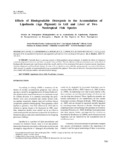Please use this identifier to cite or link to this item:
http://www.alice.cnptia.embrapa.br/alice/handle/doc/997084| Title: | Effects of biodegradable detergents in the accumulation of lipofuscin (age pigment) in gill and liver of two neotropical fish species. |
| Authors: | PEREIRA, B. F.  ALVES, A. L.   SENHORINI, J. A.   ROCHA, R. de C. G. de A.   PITOL, D. L.   CAETANO, F. H.   |
| Affiliation: | BRUNO FIORELINI PEREIRA, UNESP, Rio Claro-SP; ANDERSON LUIS ALVES, CNPASA; JOSÉ ALGUSTO SENHORINI, ICMBio/CEPTA; RITA DE CÁSSIA GIMENES DE ALCANTARA ROCHA, ICMBio/CEPTA; DIMITRIUS LEONARDO PITOL, FOR/USP, Ribeirão Preto-SP; FLÁVIO HENRIQUE CAETANO, UNESP, Rio Claro-SP. |
| Date Issued: | 2014 |
| Citation: | International Journal of Morphology, Temuco, v. 32, n. 3, p. 781-789, set. 2014. |
| Description: | Currently there is a growing concern, in both population and governments, to identify the effects of substances commonly disposed of into rivers and lakes, on aquatic fauna and flora. Thus the objective of the present study was to verify effects of biodegradable detergents and water from an urban lake on gills and liver of two neotropical fish species of great economic importance, Astyanax altiparanae and Prochilodus lineatus. In order to do so, lipofuscin, also called the ageing pigment, was used as bioindicator. After one and five months of experiment both tissues accumulated this pigment. These data are discussed from physiological points of view, related with lipid peroxidation and mitochondrial damage. |
| Thesagro: | Peixe Biodegradação Detergente Figado Pigmento |
| NAL Thesaurus: | Detergents Fish Liver Pollution Gills Astyanax Prochilodus |
| Keywords: | Lipofuscina Brânquia |
| ISSN: | 0717-9502 |
| Type of Material: | Artigo de periódico |
| Access: | openAccess |
| Appears in Collections: | Artigo em periódico indexado (CNPASA)  |










